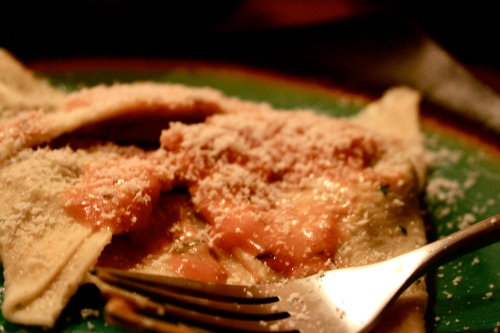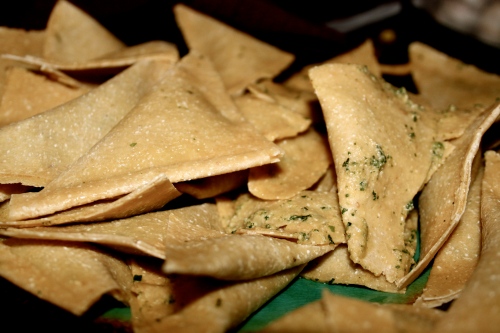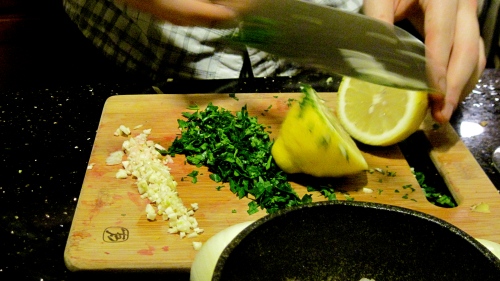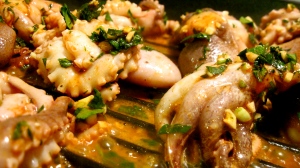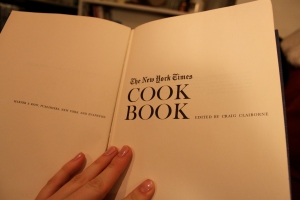Living Well on Yoga Stretches and a $5 Bill
by lyzpfister
“Well,” I said, “I can sit and watch you eat.”
He looked at me as if to say, Really, Lyz? Don’t be dumb.
So I said, “Or… we can make pasta?”
And that’s how we ended up taking the train back to Bushwick, stopping at Associated to pick up spinach and beer, and carting our yoga’d out bodies into my apartment, where the temperature was miraculously above 50 degrees.
I’d been thinking about this pasta all day. I’d had a sweet potato for lunch and wanted to do something more interesting with it than just heat it up with butter and brown sugar. So I posted my dilemma on twitter, and just moments later received a lovely suggestion to make ravioli. I had a pasta roller I hadn’t used yet and a self-imposed rule to spend no more than $5 on food and now, a friend with which to eat: oh yes, the stars had aligned.
Sweet Potato and Spinach Ravioli
For pasta:
2 cups flour
3 eggs
1 tsp salt
1 tsp olive oil
For filling:
1 yellow onion
1 large clove garlic
1 bunch of spinach
½ roasted sweet potato
¾ cups ricotta cheese
fresh grated nutmeg to taste
salt and pepper to taste
On a clean, dry surface, make a volcano-like mound of flour. In the crater, crack three eggs; add salt and olive oil. With a fork, scramble the eggs and blend with the flour. If the dough is dry, add a few drops of water until you find yourself kneading a smooth, elastic ball of dough. (Conversely, if the dough is too sticky, add more flour.) Knead the dough for about ten minutes. Let the dough rest while you prepare your filling.
Finely chop onion and garlic and sauté in a healthy amount of olive oil until the onions are translucent. Add washed spinach. When the spinach is completely tender, scrape the mixture into a food processor and blend until smooth; add sweet potato and ricotta and puree again. Season with nutmeg, salt, and pepper.
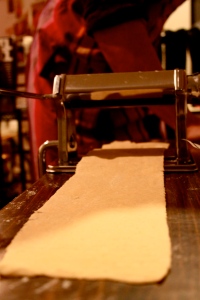 With a pasta machine, rip off chunks of dough and feed it through the machine, starting at the largest setting and folding the dough in half before dropping the setting each run-through.
With a pasta machine, rip off chunks of dough and feed it through the machine, starting at the largest setting and folding the dough in half before dropping the setting each run-through.
If you don’t have a pasta machine, you’ll need to roll out your pasta dough by hand. Separate the dough into four equal pieces. Lightly flour a large, clean surface and roll out the dough in a circular pattern with a rolling pin. The finished dough should be extremely thin – you should be able to see your hand through it.
To make the ravioli, cut the pasta strips into squares and drop about a teaspoonful of filling in the center. Brush the edges of the pasta with a beaten egg and then tightly squeeze the edges shut. Boil the ravioli in salted water for four minutes, or until done. Fresh pasta cooks much faster than dried pasta, so make sure to keep an eye on it. A watched pot might never boil, but unwatched pasta turns to mush.
This ravioli is deliciously sweet and savory, and pairs well with most tomato or white sauces. Either way, the sauce should be simple, because there’s so much flavor in the ravioli themselves. I made a basic white sauce deepened with tomato paste: Melt two tablespoons butter in a skillet on low heat; when the butter is melted, add a little bit of milk, making sure not to scald it. Add a few tablespoons of flour and whisk constantly. Add a teaspoon of tomato paste and a healthy pinch each of salt, pepper, and nutmeg. Continue to whisk, slowly adding milk until the sauce reaches a silky consistency. Finish ravioli with sauce and freshly grated parmesan.

